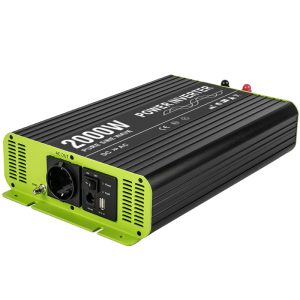When it comes to choosing an inverter for your solar power system, understanding the distinction between a pure sine wave inverter and a regular inverter is crucial. These devices convert direct current (DC) from your solar panels or battery storage into alternating current (AC) that your home appliances use. The quality of this conversion process can significantly impact the performance and lifespan of your electrical devices.
Pure Sine Wave Inverter
Key Features
- High Quality Power Output: Emulates the power you get from the utility company, making it ideal for all types of electrical devices, especially sensitive electronics.
- Efficiency: Typically operates at a higher efficiency, around 90-95%, minimizing energy loss during the conversion process.
- Compatibility: Works with virtually all AC appliances without risk of damage or interference.
Advantages
- Reduced Noise in Electronics: Produces smoother and quieter operation of appliances, including fans, lights, and audio equipment.
- Longer Appliance Lifespan: The clean, consistent power output helps extend the life of electrical devices.
- Better Performance: Ensures optimal performance for sensitive electronics like computers, medical equipment, and more.
Specifications and Costs
- Price Range: Generally more expensive due to the complex technology required, with prices often ranging from $200 to over $1000, depending on power capacity and features.
- Size and Weight: Tend to be larger and heavier due to the intricate circuitry.
Regular Inverter (Modified Sine Wave Inverter)
Key Features
- Basic Power Output: Produces a simpler form of AC power, suitable for basic power tools, lights, and non-sensitive appliances.
- Cost-Effective: Less expensive than pure sine wave inverters, making them a budget-friendly option for straightforward applications.
Advantages
- Affordability: The main benefit is cost savings, making it an attractive option for users with limited power needs or those on a tight budget.
- Simplicity: Less complex, which can translate to fewer points of failure and easier repairs in some cases.
Specifications and Costs
- Price Range: Prices can start as low as $50 for small units, making them significantly cheaper than their pure sine wave counterparts.
- Efficiency: Typically, efficiency ranges from 75% to 85%, meaning more power loss during conversion.

Detailed Comparison
Efficiency and Power Quality
A pure sine wave inverter not only operates at a higher efficiency (90-95%) but also delivers superior power quality that is almost identical to utility-supplied electricity. In contrast, regular inverters offer lower efficiency (75-85%) and produce a choppier AC signal that can harm sensitive electronics and reduce their lifespan.
Cost Implications
While pure sine wave inverters demand a higher initial investment, they can lead to savings in the long run by protecting appliances from damage and reducing energy waste. Regular inverters, though cheaper, may result in additional costs over time due to less efficient operation and potential harm to connected devices.
Application Suitability
The choice between the two types of inverters should align with the specific needs and budget constraints of the user. For environments relying on sensitive electronics, medical equipment, or where noise reduction is critical, a pure sine wave inverter is indispensable. For basic power needs or temporary setups, a regular inverter might suffice.
In summary, the decision between a pure sine wave inverter and a regular inverter involves balancing cost, efficiency, and the specific power requirements of your home or business. Understanding these factors will ensure you select the most appropriate inverter that meets your energy needs while offering the best value and protection for your investments.
